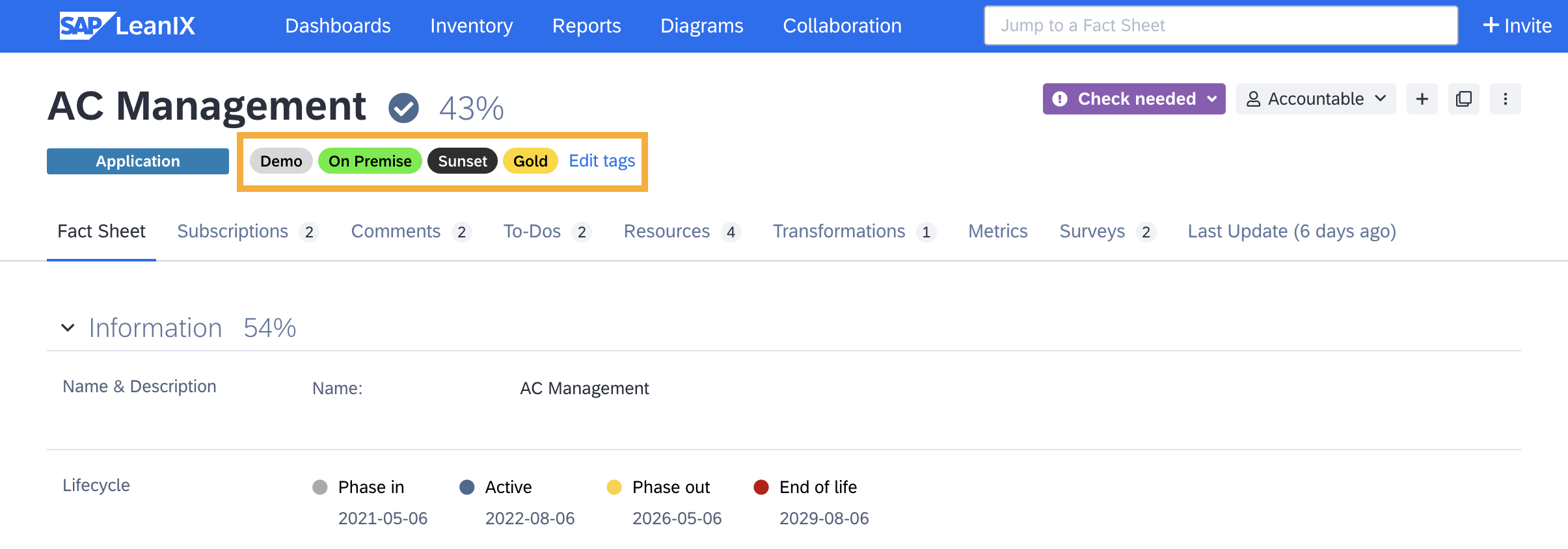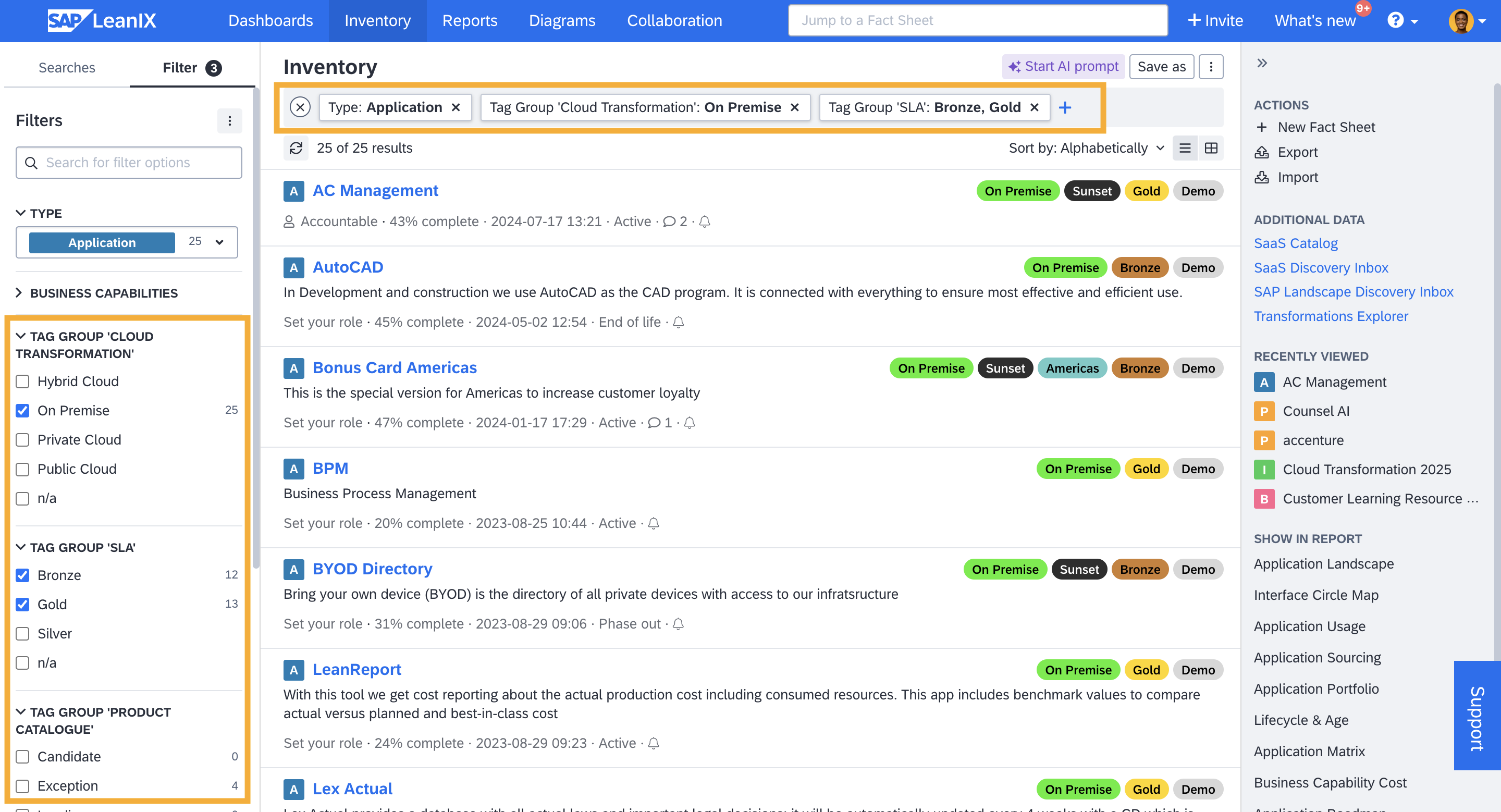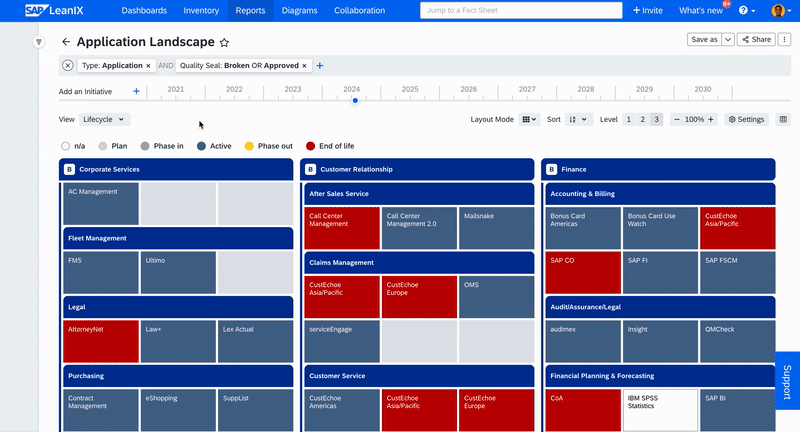Tags
Tags are labels used to classify and categorize fact sheets, making it easy to filter, organize, and analyze data. Learn how to assign and manage tags, understand when and when not to use them, as well as leverage them for filtering and reporting.
Introduction
Tags in SAP LeanIX are a powerful way to classify and categorize fact sheets to gain quick and valuable insights. They enable easy filtering and fast access to relevant information, support precise analyses, and allow for customized reporting, helping you generate meaningful insights effectively.
As compared to custom fields, tags are ideal for broad, frequently changing attributes and temporary statuses, while custom fields are better suited for detailed, specific attributes not covered by the meta model and requiring varied data types.
Admins create tag groups and tags in the administration area, which are then available in the fact sheet header to be selected and assigned. Both members and admins have the right to assign tags to fact sheets.

Tags on Fact Sheet
If admins have enabled on-the-fly tag creation, members can also create new tags as needed; otherwise, they can only assign pre-created tags. For more details on on-the-fly tag creation, see Tagging Mode. When creating tag groups, admins can define them as either single-select or multi-select, restricting users to assigning only one tag from the group or allowing them to assign multiple tags from the group.
Assigning and Removing Tags from Fact Sheets
To assign tags to the fact sheet, follow these steps:
- In the fact sheet header, click Edit tags.
- From the drop-down list, select the tag you wish to assign from the tag group.
- Click Save.
If on-the-fly tagging is active, you can create new tags that aren’t in the drop-down list. To create and assign tags on the fly, do the following:
- In the fact sheet header, click Edit tags.
- Type the name of the new tag.
- In the drop-down, click New against the tag name.
- Click Save.
To remove a tag, click the 'x' on the tag after selecting Edit tags.
Note
Tags created on the fly do not belong to any predefined tag group and by default they are categorized under the tag group Other tags. They can be assigned to tag groups by admins. To learn more, see Tagging.
However, if you need to add or remove tags for multiple fact sheets, the most efficient way is to filter the fact sheets in the inventory and either update the data across multiple fact sheets in table view or by exporting fact sheet data as an Excel file, making the update in the spreadsheet, and importing it back. To learn more, see Bulk Updating Data in Inventory Table View and Bulk Updating Data Through Excel File.
Using Tags to Filter Fact Sheets
Tags can be used to filter fact sheets in inventory, reports, and diagrams. They simplify the process of searching and filtering. Users can apply multiple tags to narrow down specific subsets of fact sheets, allowing for quicker access to the information they need.
By using tags, you can conduct more precise analyses. For example, you can tag applications with attributes like ‘High Risk’ or ‘Critical’ and then generate reports to assess the impact and risk levels across your organization.
You can apply tags as filters from the filter bar at the top or from the filter panel on the left. Simply type and search for the tag in the filter bar or find the tag group in the filter panel. To learn more, see Searching and Applying a Filter and Applying Filters From the Filter Panel.

Using Tags To Filter Fact Sheets
If the tag group you are looking for is not visible in the filter panel, you can add it to the panel through the manager filter settings. To learn how, see Displaying and Hiding Filters.
You can combine tags while filtering with AND, OR, and NONE logic to refine your search. To learn more, see Combining the Filters with AND, OR, and NONE Logic.
Using Tags as Views in Reports
Tags enable more detailed and customized reporting. You can generate insights based on specific tags to identify trends, gaps, and opportunities within your IT landscape. Simply select the needed tag group from the View drop-down list in reports. Note that only single-select tag groups are available for use as views in reports.

Using Tags as Views in Reports
Creating and Managing Tag Groups
Admins can create and manage tag groups and tags in the administration area under the section Tagging. When creating tag groups, you can limit them to particular fact sheet types if needed or make them available for all fact sheet types.
You can edit existing tags and also delete them. However, in order to delete a tag group, all the tags in that group must be deleted or removed from that tag group. Similarly, to delete a tag, all instances of that tag assigned to fact sheets must first be removed, including from archived fact sheets. For a detailed guide on creating, managing, and deleting tag groups and tags, see Tagging.
Tags v/s Custom Attributes
Knowing when to use tags versus custom attributes ensures data is organized efficiently and meaningfully. Both tags and custom fields should be used judiciously to ensure they add meaningful value and justify the effort required to maintain them.
When managing fact sheets, use tags for temporary statuses and broad categorizations, especially for important attributes with a limited number of classifications that may frequently change. Avoid tags if the information can be adequately modeled using SAP LeanIX's meta-model or if adding more tags would lead to excessive complexity.
Custom attributes are ideal for capturing specific details not covered by the meta-model, especially when various data types are required beyond a simple value list or for information relevant only to certain stakeholders. They are also beneficial for controlling access to specific users.
For a more detailed guide on when to use tags and custom attributes, see How To Use Tags vs. Custom Fields.
Updated about 1 month ago
